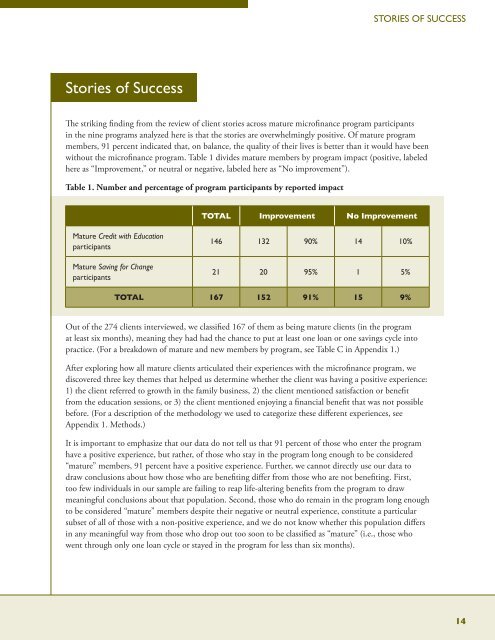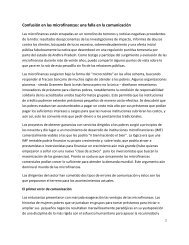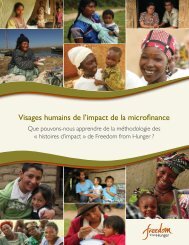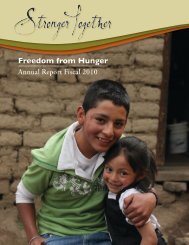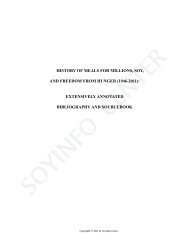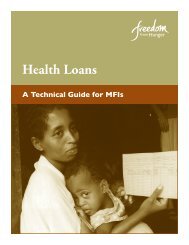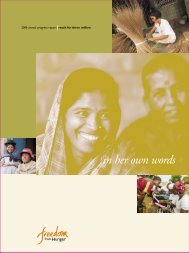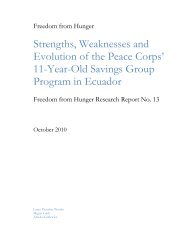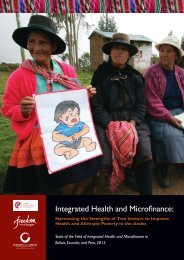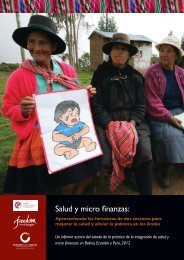English - Freedom from Hunger
English - Freedom from Hunger
English - Freedom from Hunger
Create successful ePaper yourself
Turn your PDF publications into a flip-book with our unique Google optimized e-Paper software.
stories of success<br />
The striking finding <strong>from</strong> the review of client stories across mature microfinance program participants<br />
in the nine programs analyzed here is that the stories are overwhelmingly positive. Of mature program<br />
members, 91 percent indicated that, on balance, the quality of their lives is better than it would have been<br />
without the microfinance program. Table 1 divides mature members by program impact (positive, labeled<br />
here as “Improvement,” or neutral or negative, labeled here as “No improvement”).<br />
Table 1. Number and percentage of program participants by reported impact<br />
Mature Credit with Education<br />
participants<br />
Mature Saving for Change<br />
participants<br />
TOTAL Improvement No Improvement<br />
146 132 90% 14 10%<br />
21 20 95% 1 5%<br />
TOTAL 167 152 91% 15 9%<br />
Out of the 274 clients interviewed, we classified 167 of them as being mature clients (in the program<br />
at least six months), meaning they had had the chance to put at least one loan or one savings cycle into<br />
practice. (For a breakdown of mature and new members by program, see Table C in Appendix 1.)<br />
sToRIes oF suCCess<br />
After exploring how all mature clients articulated their experiences with the microfinance program, we<br />
discovered three key themes that helped us determine whether the client was having a positive experience:<br />
1) the client referred to growth in the family business, 2) the client mentioned satisfaction or benefit<br />
<strong>from</strong> the education sessions, or 3) the client mentioned enjoying a financial benefit that was not possible<br />
before. (For a description of the methodology we used to categorize these different experiences, see<br />
Appendix 1. Methods.)<br />
It is important to emphasize that our data do not tell us that 91 percent of those who enter the program<br />
have a positive experience, but rather, of those who stay in the program long enough to be considered<br />
“mature” members, 91 percent have a positive experience. Further, we cannot directly use our data to<br />
draw conclusions about how those who are benefiting differ <strong>from</strong> those who are not benefiting. First,<br />
too few individuals in our sample are failing to reap life-altering benefits <strong>from</strong> the program to draw<br />
meaningful conclusions about that population. Second, those who do remain in the program long enough<br />
to be considered “mature” members despite their negative or neutral experience, constitute a particular<br />
subset of all of those with a non-positive experience, and we do not know whether this population differs<br />
in any meaningful way <strong>from</strong> those who drop out too soon to be classified as “mature” (i.e., those who<br />
went through only one loan cycle or stayed in the program for less than six months).<br />
14


